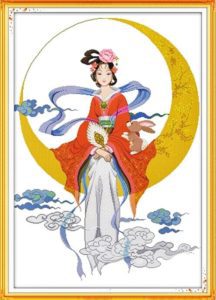
Santa didn’t usually come to my house, nor did I have many Easter baskets in my childhood. I never thought I was missing out compared to my peers, because I had Chinese New Year and Mid-Autumn Festival. Growing up Asian meant red envelopes for Chinese/Lunar New Year and mooncakes for Mid-Autumn Festival (also known as Moon Festival). Most people know about Chinese New Year being the biggest celebration on the Lunar Calendar. The Mid-Autumn Festival is not as well known, but equally as important. It is a Chinese holiday rich in traditions and really fun to celebrate with kids. Since the moon was thought to be associated with fertility, there is an underlying emphasis on appreciating children.

The festival is a celebration for the end of autumn harvest and falls on the 15th day of the 8th lunar month. It aligns with the Gregorian calendar to result in witnessing a full moon at night. In 2019, the date for the Mid Autumn Festival is September 13. Like most holidays, it involves family gatherings and partaking in good food. The festival is a time to enjoy the successful reaping of rice and wheat, and in Buddhist religion, food offerings made in honor of the moon.
Back during the Shang Dynasty (1600-1046 BC), moon worship was associated with the festival. The moon was thought to bring about rejuvenation, immortality, and fertility. In fact, the Chinese believed in a Moon Goddess named Chang’e, the deity of immortality. There are many legends and myths shared with children surrounding the festival. These stories have changed slightly over time due to science, economy, culture, and religion.

As a child, my favorite legend was about how Chang’e came to be the Moon Goddess. In ancient history, there was a hero named Hou Yi who excelled at archery. His wife was Chang’e. One year, ten suns rose in the sky, causing great disaster to the people. Yi shot down nine of the suns and left only one to provide light. As a sign of gratitude, he was sent the elixir of immortality. Yi did not want to leave Chang’e and be immortal without her, so he hid the elixir. However, Peng Meng, one of his apprentices, knew about this gift and broke into Yi’s house to steal it. Chang’e refused to let him take it, so she swallowed the elixir herself. With that, she flew into the sky and lived in the moon. When Yi returned home and learned of what happened, he was deeply saddened. He decided to display all of Chang’e’s favorite fruits and cakes in the yard, so she could see them from the moon. As others learned about Yi’s loss and love for his wife, they decided to participate in sympathetic support. That’s how the Mid-Autumn Festival came about.
While the moon continues to be viewed as a symbol of harmony and unity, modern celebrations are simply centered around thanksgiving and gathering together. People also celebrate the day with dances, outdoor barbecues, parades, and lighting of lanterns. Today, it is an occasion for eating of mooncakes, lunar appreciation, outdoor family reunions, and moon watching.















